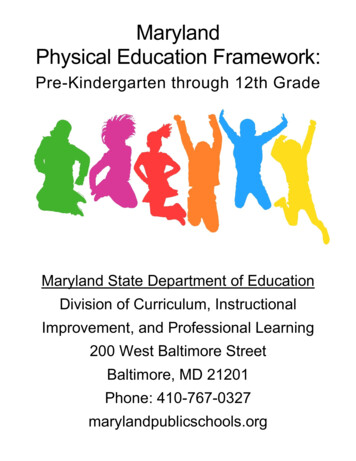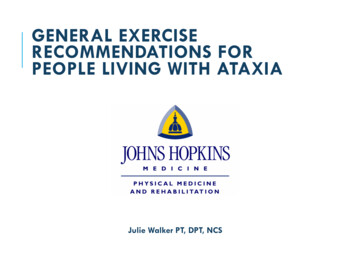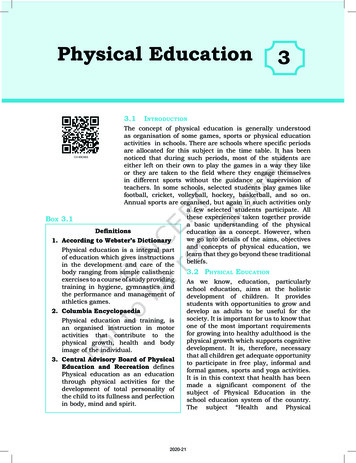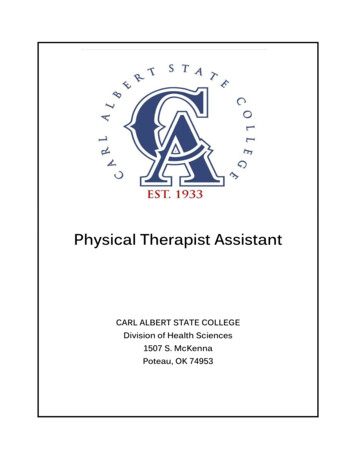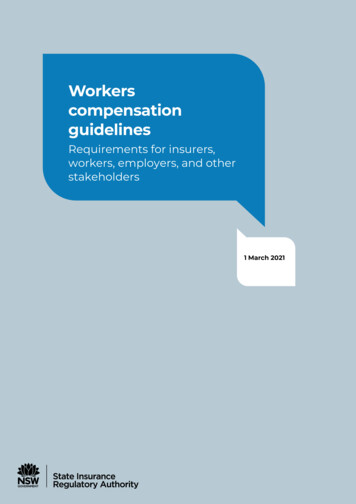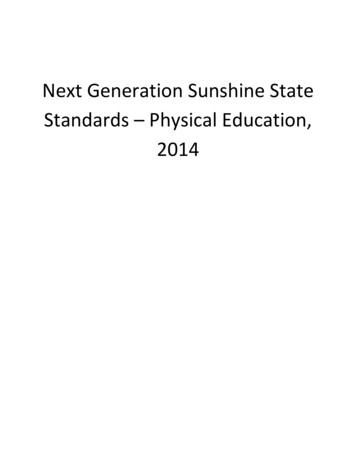
Transcription
ADAPTED PHYSICALEDUCATION GUIDELINESIN CALIFORNIASCHOOLSCalifornia Department of EducationSpecial Education DivisionApproved 2001Revised 2012
ACKNOWLEDGMENTSThe Adapted Physical Education Guidelines in California Public Schools Revised is theresult of the collaborative efforts of many professionals. The need for this revised guidelineemanated from requests for updated legal references and curricular programming by teachers,administrators and parents who used the first edition of the guidelines on a daily basis. Thesupport for the revision came from the California Department of Education and theCalifornia Association for Health, Physical Education, Recreation, and Dance (CAHPERD)State Council on Adapted Physical Education (SCAPE).Financial support for this project was provided by SCAPE. Acknowledgements are made tothe school districts of the guidelines committee for contributing to this project by providingsubstitutes for writing days, allowing the committee to meet numerous times and for graphicssupport.GUIDELINES REVISION COMMITTEEKimble Morton, Motor Assessment Program Specialist, Diagnostic Center, Southern CaliforniaJoanie Verderber, Ph.D., Project Director III, School Health and Physical Education Programs, LosAngeles County Office of EducationPerky Vetter, Ph.D., Kinesiology and Health Promotion Department Chair, Adapted PhysicalEducation Program Coordinator and Motor Development Clinic Director; Cal Poly PomonaCarrie Flint, Adapted Physical Education Teacher, Lawndale USD, CADebbie Foster, Middle School Physical Education Teacher, Claremont USD, CALindsay Cecil, Adapted Physical Education Teacher, Los Angeles USD, CAMarcia Pope, Faculty, California State University, Chico, CACONSULTANTSThe Guidelines Committee would like to thank the following individuals for their input:Rahnia Hassan, PT, DPTVivien Sit, MOT OTR/L, Lawndale Elementary School DistrictScott Kerby, Director, Special Schools and Services Division, California Department ofEducation2Note: All statutory citations apply to the California Education Code unless otherwise stated.ADAPTED PHYSICAL EDUCATION GUIDELINES
TABLE OF CONTENTSPagePreface. 1Acknowledgements.2Chapter 1Introduction to Adapted Physical Education Guidelines . 5Chapter 2Roles and Responsibilities. 12Chapter 3Provision of Adapted Physical Education Services . 19Chapter 4Individualized Educational Programs . 41Chapter 5Adapted Physical Education, OT and PT . 53Chapter 6Adapted Physical Education in Private, Non-Public & Charter Schools 58Chapter 7Early Intervention – Infants and Toddlers . 62Chapter 8Transition to Adult Life . 71Chapter 9Program and Administrative Considerations . 78Chapter 10Curriculum and Instruction, Fitness Testing and Exemptions . 93Chapter 11Facilitating Communication with Other School Staff .107References.115List of Appendices .118Appendix A Glossary of Terms .119Appendix B Checklists for Referral and Introduction .127Appendix C Assessment Tools and Tests .131Appendix D Adapted Physical Education Report of Assessment.137Appendix E Alignment of Physical Education Standards .159Appendix F Grade Level Guidelines: Curriculum Benchmark Examples .170Appendix G Quality Indicators: Lessons, Teaching and Program . 1893Note: All statutory citations apply to the California Education Code unless otherwise stated.ADAPTED PHYSICAL EDUCATION GUIDELINES
Appendix H Lesson Planning, Data Collection Forms .190Appendix IOrdering and Managing Equipment .195Appendix JAdapted Physical Education Authorization Credential Standards .197Appendix K Physical Education Single Subject Credential Standards.200Appendix L Adapted Physical Education Website Resources .201Appendix M California Department of Education Memo Regarding Related Service.206Appendix N Letter from CDE, Division of Special Education .2104Note: All statutory citations apply to the California Education Code unless otherwise stated.ADAPTED PHYSICAL EDUCATION GUIDELINES
CHAPTER 1 - INTRODUCTION TO ADAPTED PHYSICALEDUCATION GUIDELINESREVISIONIn 2001 the Adapted Physical Education Guidelines were approved by the CaliforniaDepartment of Education (CDE), Special Education Division (see appendix N). Since then,state and federal laws have changed, the Physical Education Model Content Standardshave been written and the Commission on Teacher Credentialing (CCTC) has revised theAdapted Physical Education Credential Standards. These events indicated a need forrevision of the Adapted Physical Education Guidelines. Some members of the originalwriting team convened a new writing team that was comprised of three of the originalmembers and four other professionals. The broad background and expertise of thiscommittee provided a writing team with a well-versed perspective. Questions, concernsand input from the field were collected and considered when writing this document.It is the intent of this revision to cite updated legal references for the California EducationCode, California Code of Regulations, Title 5 and Code of law of the USA, Title 20Education, and Part B Regulations of Aug. 1, 2006, supplemented December 31, 2008(regulations that reflect IDEA ’04). The curriculum chapter has been rewritten to address thePhysical Education Model Content Standards for California Schools and the state-mandatedphysical fitness testing applied to individuals with a disability. In response to suggestionsand questions from the field, the service delivery model has been revised for clarity,assessment procedures have been revised, curriculum chapter has been updated includinginformation on fitness testing for individuals with a disability and many chapters have beenenhanced. The purpose of these Guidelines has not changed and it continues to reflect thecurrent best practices for California adapted physical education.PURPOSEThe purpose of this document is to identify program guidelines that clarify adaptedphysical education services. These are provided to individuals with disabilities who requirehighly specialized services to meet their individual goals for physical education thatincludes movement education and motor development. These Guidelines are organized bygroups of key provisions that are followed by legal requirements, discussion and bestpractice statements, to be used when identifying, assessing, planning and implementingquality physical education programs. When determining appropriate adapted physicaleducation services, educational personnel, other agency and community personnel, parentsand individuals may reference these guidelines. Educational personnel include, but maynot be limited to, teachers, support personnel and administrators. Examples of otheragency and community personnel include physical therapists, occupational therapists,social workers and medical personnel.The Adapted Physical Education Guidelines in California Schools:5Note: All statutory citations apply to the California Education Code unless otherwise stated.ADAPTED PHYSICAL EDUCATION GUIDELINES
Clarify eligibility for adapted physical education services. Identify physical education service delivery options. Provide information to evaluate, improve and maintain quality adapted physicaleducation services throughout California. Provide criteria for conducting self-review and monitoring of adapted physicaleducation services. Provide a resource for special education local planning areas (SELPAs), countyoffices of education and local education agencies (LEAs) to use in developing localplans, policies and procedures to address the physical education needs of individualswith disabilities. Establishes key provisions that are consistent with federal and state laws andregulations. Clarify the differences and similarities among adapted physical education and physicaland occupational therapies. Clarify the role and responsibilities of an adapted physical education teacher. Include best practices for inclusion within the physical education setting. Clarify transition services. Addresses the relationship of Physical Education Model Content Standards forCalifornia Schools to children with disabilities.RATIONALE FOR PHYSICAL EDUCATIONThe many benefits of physical activity have been documented through years of researchincluding those contained in Leading Health Indicators for Healthy People 2020. Thesebenefits include increased muscular strength, stimulation of bone growth, cardiovascularfitness and flexibility, which enable the body to move and function more efficiently andcontribute to personal health. In addition, individuals can attain higher levels of functionalmovement skills, fundamental movement patterns and skills and sport skills by receivingphysical education and participating in physical activity. The attainment of these skills andpatterns promotes a higher quality of life and greater opportunity for social interaction withothers.Quality physical education programs provide opportunities for individuals to attainmovement and sport skills that can be applied to physical activities across the lifespan.Opportunities are also provided for individuals to develop increased levels of lifetimephysical and health fitness, which contribute to an active lifestyle. Embedded within theprogram should also be cognitive/knowledge based learning as well as demonstration andutilization of knowledge of psychological and sociological concepts, principles, andstrategies as applied to learning and performance of physical activity.The President’sCouncil on Physical Fitness & Sport (2010) has published a position statement regardingphysical activity and individuals with disabilities. Another initiative Let’s Move (2010),stresses the importance of nutrition and physical activity as America strives to raise ahealthier generation of children and youth. The initiative also stresses the importance ofworking with families of individuals with a disability to ensure that physical activities are6Note: All statutory citations apply to the California Education Code unless otherwise stated.ADAPTED PHYSICAL EDUCATION GUIDELINES
part of the individual’s learning plan during and after school. Individuals with disabilities,for the most part, can gain very similar benefits from physical activity and increase levels ofphysical fitness as people without disabilities.LEGAL REFERENCE TO PHYSICAL EDUCATIONFederal LawThe most significant federal legislation, which has impacted physical education services forindividuals with disabilities, was the Education of All Handicapped Children Act of 1975,PL 94-142. This legislation identified physical education as a curriculum area that was to beprovided for ALL children with disabilities (handicapping conditions). To date, physicaleducation continues to be a curriculum area identified in federal law. PL 108-446,Individuals with Disabilities Education Improvement Act (IDEIA or IDEA 2004) passed in2004 which aligned IDEA with the No Child Left Behind Act of 2001. It continues to ensurethat all children, regardless of disability, receive physical education (20 U.S.C. sec. 1401Definitions (29)). Some of these children require specialized instruction in physicaleducation. As a result of these needs, different services are required; a service deliverymodel demonstrating a continuum of service options for physical education programs hasevolved as well.At the federal level, there are two types of laws and regulations that govern specialeducation services. They are public laws and federal regulations. The Individuals withDisabilities Education Improvement Act of 2004 (IDEA), as one of the many reauthorizations of PL 94-142, continues to identify the curriculum content area of physicaleducation for individuals with disabilities. As this federal law changes, the FederalEducation Code, Title 20 (20 U.S.C.) is modified to include all of the provisions of IDEA.The Code of Federal Regulations (34 CFR), which carries out the intent of 20 USCEducation, is amended as the codes change and contains more complete descriptions ofprograms and services. These various laws and regulations will be referenced in thisdocument by their abbreviations.In the 34 Code of Federal Regulations, physical education is defined as a part of specialeducation.§300.39(a)(ii) Special education.(a) General. (1) Special education means specially designed instruction, at no cost tothe parents, to meet the unique needs of a child with a disability, including—(i) Instruction conducted in the classroom, in the home, in hospitals and institutionsand in other settings; and(ii) Instruction in physical education.In that same section, sec 300.39 (b) (1), (2), and (3), it defines Special Education,Physical Education, and specially designed instruction: (b) Individual special education terms defined. The terms in this definition aredefined as follows:7Note: All statutory citations apply to the California Education Code unless otherwise stated.ADAPTED PHYSICAL EDUCATION GUIDELINES
(1) At no cost means that all specially-designed instruction is provided withoutcharge, but does not preclude incidental fees that are normally charged tonondisabled individuals or their parents as a part of the regular education program.(2) Physical education means—(i) The development of—(A) Physical and motor fitness;(B) Fundamental motor skills and patterns; and(C) Skills in aquatics, dance and individual and group games and sports (includingintramural and lifetime sports); and(ii) Includes special physical education, adapted physical education, movementeducation, and motor development.(3) Specially designed instruction means adapting, as appropriate to the needs of aneligible child under this part, the content, methodology-, or delivery of instruction—(i) To address the unique needs of the child that result from the child's disability; and(ii) To ensure access of the child to the general curriculum, so that the child can meetthe educational standards within the jurisdiction of the public agency that apply to allchildren.California LawAs at the federal level, several laws, education codes and regulations govern education at thestate level. In California, adapted physical education is defined in the California Code ofRegulations, CCR, Title 5, under Sec. 3051.5(a) and is listed as a designated instruction andservice (DIS) and a related service in California Education Code Section 56363 (a) and(b)(5).Adapted physical education as defined in 5 CCR Sec. 3051.5 (a) Adapted physical educationis for individuals with exceptional needs who require developmental or corrective instructionand who are precluded from participation in the activities of the general physical educationprogram, modified general physical education program, or in a specially designed physicaleducation program in a special class. Consultative services may be provided to pupils,parents, teachers, or other school personnel for the purpose of identifying supplementaryaids and services or modifications necessary for successful participation in the regularphysical education program or specially designed physical education programs.Refer to Appendix M (particularly the highlighted paragraph) for the California Departmentof Education memo explaining adapted physical education as a related service.All children, unless excused or exempt under Section 51241, are required to have anappropriate physical education program. In addition, these services should be provided insuch a manner that promotes maximum interaction between children with disabilities andtheir non-disabled peers as provided in the United Stated Code ((20 U.S. C. Sec. 1412 (a)(5)). These codes ensure the rights of all children to have an appropriate physical education8Note: All statutory citations apply to the California Education Code unless otherwise stated.ADAPTED PHYSICAL EDUCATION GUIDELINES
program with peers.Need for Adapted Physical Education for Individuals with Various DisabilitiesSome children may need an adapted physical education program, as they cannot successfullyparticipate in activities of the general or specially designed physical education programs -even with accommodations and/or modifications. These needs may be the result ofmovement delays or difficulties, physical or neurological disabilities, health and physicalfactors, emotional disorders, behavior difficulties or cognitive delays.Physical education for individuals with disabilities has undergone several name changessince programs were first established in the 1950s. Initially, the program was referred to ascorrective physical education and was offered to individuals with physical disabilities thatwere either acute or chronic. Other names for the program have included remedial physicaleducation, adaptive physical education, and adapted physical education. Some of these namechanges have been linked to the enactment of Public Law 94-142 and its reenactments. Inaddition, the changes reflect a shift in focus from rehabilitative programs, which followed amedical model, to those, which emphasize active and healthy lifestyles, which reflect theeducational model.Adapted vs. Adaptive:In California, the physical education program designed for individuals with disabilities iscalled adapted physical education as it is defined in 5 CCR Sec.3051.5 The program isadapted to meet the needs of each student through modifications and accommodations. Thestudent is not required to adapt to the conditions of the program as would be implied withadaptive physical education as in adaptive behaviors.Program Advisory Clarifying Adapted Physical Education Program Services:Individuals with disabilities, who are eligible for special education and related services, havea right to a free and appropriate public education to meet their unique needs. Theseeducational services may include adapted physical education. In addition, the fields ofadapted physical education, physical education and special education have developedprofessional practices, which are effective in providing quality services for individuals withdisabilities.Based upon these requirements, policies, practices and procedures, the California Departmentof Education worked collaboratively with SCAPE to develop the Program AdvisoryClarifying Adapted Physical Education Services. In 1993, the Deputy Superintendent ofSpecialized Programs for the California Department of Education signed this advisory intoeffect. One purpose of the Program Advisory was to describe the variety of physicaleducation services available for children with disabilities with the intention of assistingdistricts, counties and regions to establish consistent programs throughout California. Theother purpose of the Program Advisory was to identify practices which could be used asguidelines for adapted physical education programs. The Program Advisory, with thesupport of the California Department of Education, Division of Special Education, was9Note: All statutory citations apply to the California Education Code unless otherwise stated.ADAPTED PHYSICAL EDUCATION GUIDELINES
revised and expanded into the Adapted Physical Education Guidelines in California PublicSchools in 2003. Since that time, IDEA ’04 was passed at the federal level and the Californiaeducation laws have been amended in order to comply with federal law. Therefore, thisrevision of the Adapted Physical Education Guidelines in California Public Schools has beenupdated and revised to reflect current law and best practice.Guiding Documents:As a result of educational reform, curriculum standards have been written for the varioussubject areas including physical education. These standards provide the basis for curriculumdevelopment. Curriculum standards indicate what individuals, at a given grade level, shouldknow and be able to do. The Physical Education Model Content Standards for CaliforniaPublic Schools were written in 2005 with statewide training for school districts includingadapted physical education teachers. Districts are not required to adopt state standards;however, many utilize these Model Content Standards. In 2008 the Physical EducationFramework, based on the content physical education standards, was adopted by theCalifornia Department of Education, providing further guidance to California educators fordevelopment of curriculum and instruction physical education. One purpose for revising theAdapted Physical Education Guidelines is to assist educators utilizing all three documents toguide physical education instruction for individuals with disabilities; particularly those whorequire adapted physical education.Collaboration:A collaborative approach is recommended for adapted physical educators to maximize thequality of education provided for individuals with a disability. Effective collaborationrequires a team of people working toward a common goal while each provides input fromtheir disciplinary perspective. The adapted physical education teacher is often one member ofsuch a team. The law requires a multi-disciplinary individualized education program (IEP)team. The IEP team is most effective if members adopt a collaborative approach anddemonstrate collaborative characteristics and skills which include: open, two-waycommunication, solution-oriented problem solving strategies, mutual respect; and the sharingof ideas and resources. When a student receives two or more services, (e.g., APE andPhysical Therapy) collaboration between and among disciplines may result in greater benefitto the student with a disability. A student with a disability may need assistive devices andspecific exercises as identified by a therapist. In such a case, the adapted physical educationteacher as well as the special education teacher, should be aware of how to use thespecialized equipment and how to perform the exercises. On the other hand, the student mayperform physical education skills with their peers that they are not motivated to perform intherapy sessions. By communicating with the therapist, the adapted physical educationteacher can report to others about skill transfer to educational settings that involve groupparticipation. The therapist can report on increases in areas such as strength, range of motionand balance.USE OF THESE GUIDELINESThese guidelines contain key provisions, references to federal and state laws, education10Note: All statutory citations apply to the California Education Code unless otherwise stated.ADAPTED PHYSICAL EDUCATION GUIDELINES
codes and regulations, standards (credential and curriculum) and best practices. Legal references provide support for the key provisions and are cited. All statutorycitations apply to the California Education Code unless otherwise stated. Abbreviationsfor laws and regulations are:CFR: Code of Federal Regulations;USC: United States CodePL:Public LawCCR: California Code of RegulationsEC: Education Code (California) Credential standards are located in Appendix J and K and have been approved by theCalifornia Commission on Teacher Credentialing. Physical Education Model Content Standards for California Schools are addressed inChapter 10 and located in Appendix E. Best practice examples are addressed under each key provision throughout the document.In the original of this document (2004), all legal references were reviewed and approved bythe legal team of the California Department of Education, Division of Special Education. Inthis revised document the legal references have been updated by professionals in the field. KEY PROVISIONS developed for these guidelines are denoted by the box around thekey provision statement. The term key provision has been used in this revision in place ofterm “standard”. This change in terminology was selected to prevent confusion with other“standards” used in the profession – credential standards and curriculum standards.11Note: All statutory citations apply to the California Education Code unless otherwise stated.ADAPTED PHYSICAL EDUCATION GUIDELINES
CHAPTER 2 - ROLES AND RESPONSIBILITIESADAPTED PHYSICAL EDUCATION CREDENTIAL2.1 KEY PROVISION: The person providing instruction and services shall have acredential authorizing the teaching of adapted physical education as established by theCalifornia Commission on Teacher Credentialing. Refer to Appendix J for the credentialstandards.Legal Reference: 5CCR Sec. 80046.1 (a) All individuals assigned to teach adapted physicaleducation shall hold an Adapted Physical Education authorization.5 CCR Sec. 80046.1(c) Authorization. The Adapted Physical Education Added Authorization,the Adapted Physical Education Specialist Credential, and the Adapted Physical EducationEmphasis Credential authorize the holder to conduct Educational Assessments related tostudent's progress towards meeting instructional physical education goals, provideinstruction, and Special Education Support to teach students with special needs who areprecluded from participation in the activities of the general physical education program or aspecially designed physical education program in a special class, from birth through age 22,including preschool, and in classes organized primarily for adults.Discussion: Since the early 1970s, various universities in California have offered acertificate to those individuals who completed coursework and fieldwork in the area ofadapted physical education. In the mid1970s, a number of university instructors wrote adocument entitled “Scope and Content of Adapted Physical Education.” This was later usedby the California Commission on Teacher Credentialing (CCTC) as the means by whichadapted physical education teachers were credentialed. In 1979, CCTC first authorized thecredentialing of adapted physical education teachers, and by 1985 all teachers in adaptedphysical education had to be credentialed. There were originally 21 universities whosubmitted their “scope and content” documents to CCTC and were approved to credentialadapted physical education teachers.It was soon evident that the “scope and content” document was not fulfilling the criterianeeded to be an adapted physical education teacher in California. A number of universitycoordinators of adapted physical education met, and with the support of CCTC, wroteprogram quality standards for the adapted physical education teacher. This document wasapproved in December 1993 and university programs began the review process in 1997. Asof fall 1999, 12 California state universities received CCTC program approval prior toenrolling individuals in their credential program. Since the 1990s, the program standardshave fulfilled the needs of professional preparation programs. However, it became clear thatthe adapted physical education credential program should also be available for specialeducation teachers.12Note: All statutory citations apply to the California Education Code unless otherwise stated.ADAPTED PHYSICAL EDUCATION GUIDELINES
In July 2011, the Adapted Physical Education Program Credential Standards were revised,approved by CCTC and Title 5 was also updated (Title 5 Sections 80046.1), refer toAppendix J for the actual standards. At the same time the adapted physical educationcredential became an authorization along with many other special education programs, suchas learning disabled, autism and moderate to severe disabilities.In order to teach adapted physical education to individuals in California public schools,according to Title 5, the teacher must hold a credential authorizing the teaching of physicaleducation (single subject physical education, multiple subject, physical educationsupplementary authorization or special education) and have the adapted physical educationauthorization.All individuals holding an adapted physical education credential have met the competenciesauthorizing the teaching of adapted physical education. However, the expertise of adaptedphysical education teachers, like teachers in general, will vary, based on their professionalpreparation, experience and knowledge. Therefore, consideration of specific skills and areasof expertise may be necessary when hiring a person to teach adapted physical education.Best Practice: An adapted physical education credential authorizes the teacher to teachadapted physical education. If a credentialed person cannot be found, the employer shouldemploy an individual who is currently enrolled in a CCTC approved adapted physicaleducation credential program. In addition to credential competencies, an adapted physicaleducation teacher may have specific skills and training in areas such as autism, behaviorintervention, infant and toddler, adapted aquatics, MOVE, etc. When hiring an adaptedphysical education teacher the qualifications of the candidate should be matched to needs ofthe LEA (Local E
Adapted Physical Education Credential Standards. These events indicated a need for revision of the Adapted Physical Education Guidelines. Some members of the original writing team convened a new writing team that was comprised of three of the original members and four other professionals. The broad background and expertise of this

